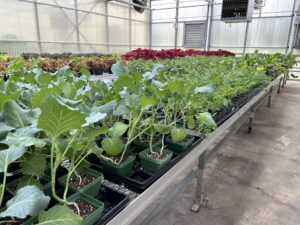With a picky palate like lots of his human friends, Goji the Bearded Dragon rejected his last treat of nasturtium, an annual plant with bright, edible flowers.
“Probably too peppery,” says Renee Oakley, facility manager at the Fox Valley Park District’s Red Oak property in North Aurora. “They’ll let you know quickly and decisively if something has fallen out of favor.”
Goji resides with an impressive cast of critters who call Red Oak Nature Center home. And each week, the dragon and a group of 15 lizards, turtles and tortoises, along with colonies of roaches and millipedes, receive a drop of freshly grown produce from their favorite “delivery app” – the Charles Myler Horticulture Center.
Owned and operated by FVPD, the horticulture center stands in the northeast corner of Lincoln Park on Aurora’s west side and features a 13,000-square-foot greenhouse where Mylane Bryant and her staff nurtures and grows thousands of annuals and perennials for the dozens of beds and containers at facilities across the District. Shortly after Bryant started as FVPD’s horticulture and natural areas supervisor in 2023, Oakley reached out and asked about the feasibility of growing ruffage to supplement the protein Red Oak animals receive while noshing on main courses like crickets and mealworms.
 “It took a little time to get into a good routine because I don’t spray with pesticides,” Bryant says. “And what that means is occasionally I’ll have to restart because the crop gets infested with caterpillars or aphids, which are small sap-sucking insects. It took six months to get into a good routine where we could supply product every week.”
“It took a little time to get into a good routine because I don’t spray with pesticides,” Bryant says. “And what that means is occasionally I’ll have to restart because the crop gets infested with caterpillars or aphids, which are small sap-sucking insects. It took six months to get into a good routine where we could supply product every week.”
Well worth the wait (and weight), the result is an every-Monday haul of five to six zip-sealed bags of carrot tops, Swiss chard, collard, kale and parsley.
“These greens are salad-worthy!” Oakley says. “These are the animals’ vitamins and minerals; it’s like what we should be eating in our diet – the good veggies to get those nutrients they need. And we’re taking care of them in the most sustainable way we can.”
Oakley would normally spend $10 on a bag of organic greens, and while the modest savings do add up, the simple practice of tapping into existing resources promotes sustainability through an environmentally-friendly initiative.
The process
Inside the greenhouse, Bryant and her team sows the seeds in trays before they’re placed into a “mist system.” Upon germination, the tiny plants get potted into four-inch containers, grown out in pods, and harvested from there.
“Some things take a little longer,” says Bryant, whose staff is currently planting 18,000 plugs and plants in more than 50 beds and dozens of containers across the District during annual spring beautification projects.
“The talent of the greenhouse, they’re willing to help the Park District in a different way – they’re not just growing for looks, they’re growing for sustainability of food,” Oakley says. “It’s nice to provide for the animals the best we can – and consistently. Mylane and her staff allow us to do that.”
The growers get rewarded, too.
“It’s a fun thing to do and we’re just one part of it,” Bryant says. “I’ve always enjoyed the connection of growing and then providing nutrition for either animals or humans. It’s a nice thing for us to be involved in.”
Interested in learning more about all things Red Oak? Stop by the Nature Center at 930 N. River Rd. (Rte. 25) in North Aurora between 10 a.m. and 4 p.m. Tuesday-Friday, or 10 a.m. to 2 p.m. Saturday; visit www.redoaknaturecenter.info; or call 630-897-1808. The Charles Myler Horticulture Center and Greenhouse are not open to the public; however, tours by appointment are provided to school, scout and senior groups. Call 630-897-4261 for more information.
